Setup
Angles
Angles have different kinds of units associated with them: turns (1 turn = one full rotation a circle), degrees (1 turn = 360 degrees), and radians (1 turn = = ).
I like π just fine, but I agree with Michael Hartl’s Tau Manifesto that we would have been better off if we had recognized that the number of radians to complete a full turn of a circle (τ = 2π ≈ 6.283185) is more fundamental than the number of radians to complete a half turn (π).
| Turns | Radians | Degrees |
|---|---|---|
Code
theta <- degree(seq(0,330, 30))
angle_types <- c("Turns", "Radians", "Degrees")
theta_list <- lapply(list(turn, radian, degree), \(.a) .a(theta))
p <- ob_polar(theta, r = 1)
r <- seq(1, .5, length.out = length(angle_types))
my_shades <- (tinter::tinter("royalblue",
steps = 7,
direction = "tints")[seq_along(angle_types)])
ggplot() +
coord_equal() +
theme_void() +
ob_circle(
center = ob_point(),
radius = r,
fill = my_shades,
color = NA,
linewidth = .25
) +
ob_segment(ob_point(), p, linewidth = .25) +
purrr::pmap(
.l = list(r, theta_list, my_shades),
.f = \(rs, ts, ss) {
ob_circle(radius = rs - 1/8)@point_at(ts)@label(ts, fill = ss, size = 16)@geom(family = my_font)
}) +
ob_point(0, y = r - 1 / 18)@label(angle_types,
fill = my_shades,
fontface = "bold",
family = my_font,
size = 16)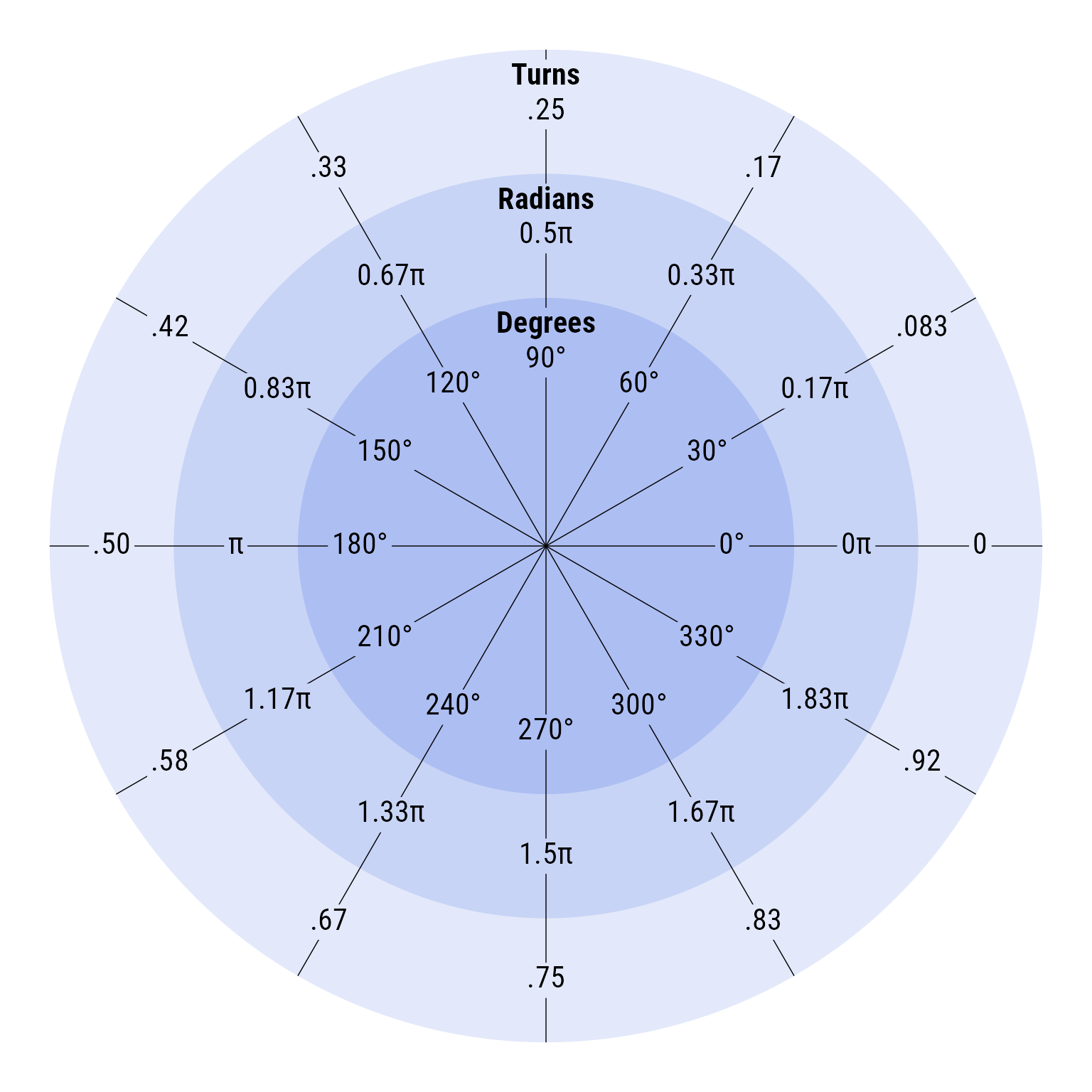
One can create equivalent angles with any of the three metrics.
Although these methods have convenient printing, under the hood they are ob_angle objects can retrieve angles in any of the the three metrics.
Character Printing
For labeling, sometimes is convenient to convert angles to text:
as.character(degree(90))
#> [1] "90°"
as.character(turn(.25))
#> [1] ".25"
as.character(radian(.5 * pi))
#> [1] "0.5π"Angle Metric Conversions
Any of the metrics can be converted to any other:
Arithmetic Operations
Angles can be added, subtracted, multiplied, and divided. The underlying value stored can be any real number (in turn units), but degrees, radians, and turns are always displayed as between −1 and +1 turns, ±360 degrees, or ±2π radians.
30° + 60° = 90°
Code
make_angles <- function(a = c(80, 300),
r = c(.1, .2, .3),
label_adjust = c(0,0,0),
multiplier = c(1.4,1.4,1.4)) {
start_angles <- degree(c(0,a[1], 0))
end_angles <- degree(c(a[1], sum(a), degree(sum(a))@degree))
arc_labels <- as.character(end_angles - start_angles)
mycolors <- c("firebrick4", "royalblue3", "orchid4")
arc_labels[3] <- paste0(arc_labels[1],
" + ",
arc_labels[2],
" = ",
arc_labels[3])
arcs <- ob_arc(radius = r,
start = start_angles,
end = end_angles,
label = ob_label(arc_labels,
color = mycolors,
family = my_font),
linewidth = .25,
length_head = 10,
arrow_head = arrowhead(),
color = mycolors)
ggplot() +
theme_void() +
coord_equal() +
arcs +
ob_segment(
p1 = ob_point(),
p2 = ob_polar(theta = degree(c(0,a[1],sum(a))), r = 1),
length_head = 5,
linewidth = .75,
arrow_head = arrowhead(),
color = c("firebrick", "firebrick", "royalblue"))
}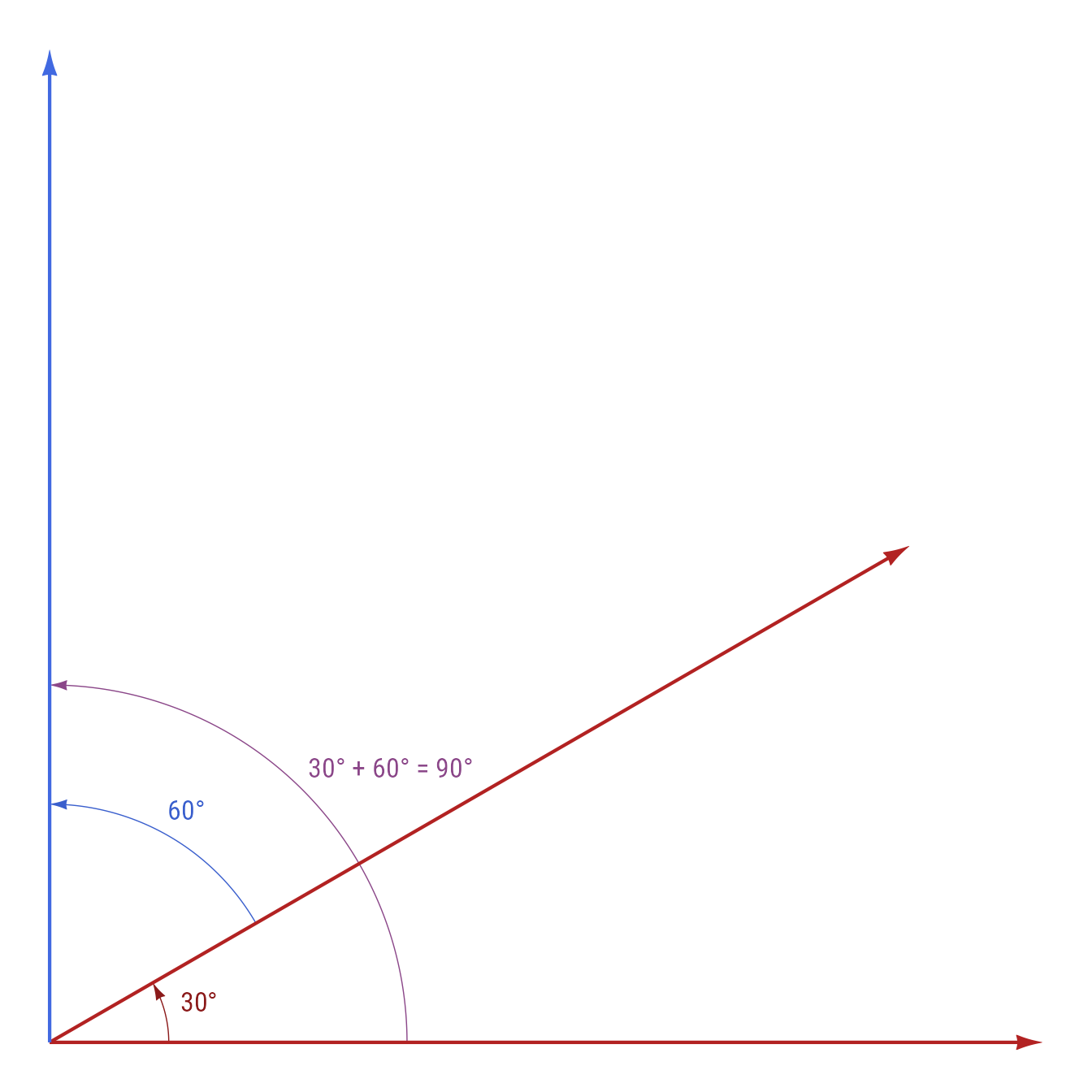
Adding a number to the degree class assumes the number is in the degree metric.
degree(30) + 10
#> [1] "40°"Likewise, adding a number to a radian (or an angle by default) makes a radian:
radian(pi) + 0.5 * pi
#> [1] "1.5π"Turns work the same way:
turn(.1) + .2
#> [1] ".30"When degrees are outside the range of ±360, they recalculate:
Code
make_angles(c(80, 300)) 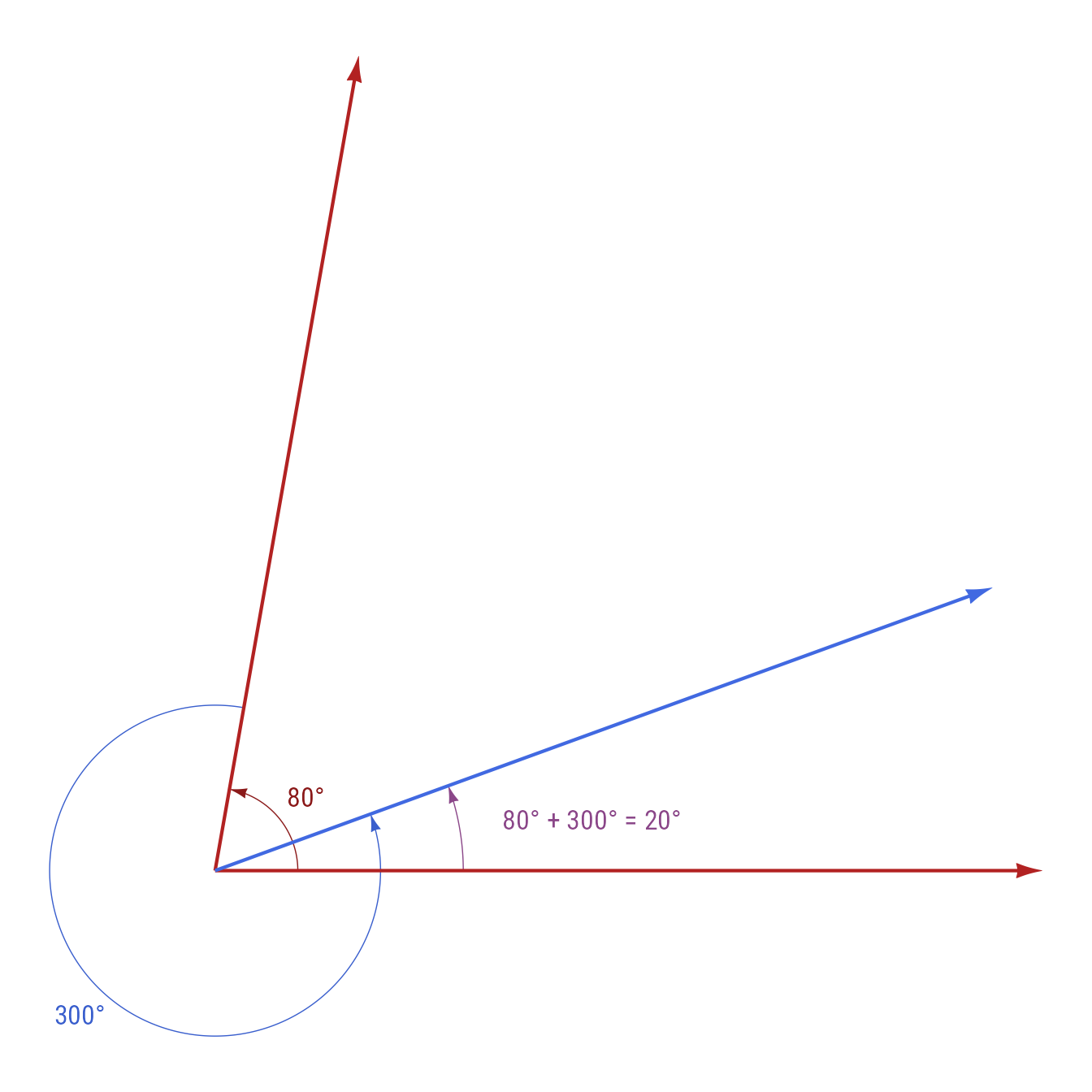
Code
make_angles(c(40, -60)) 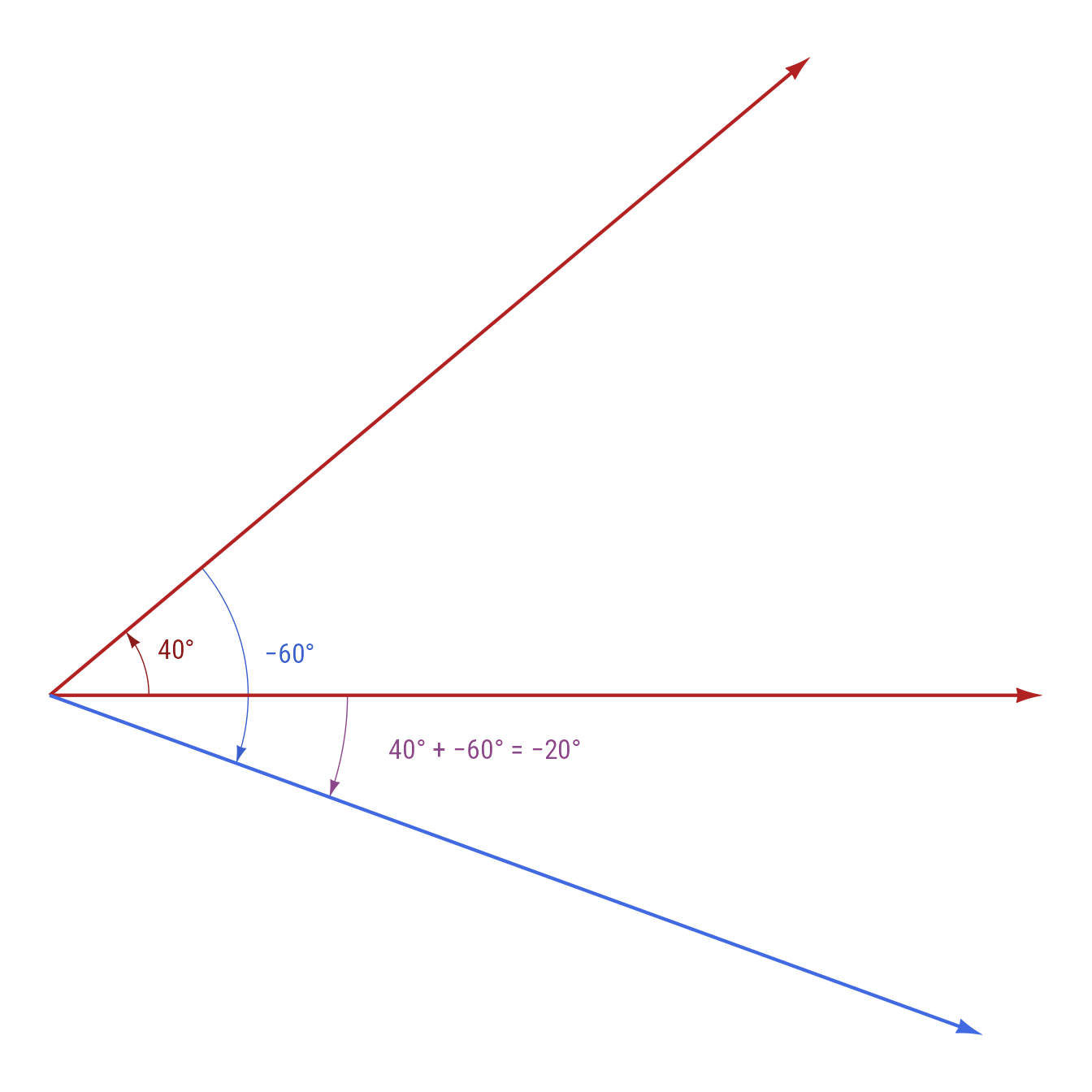
2 * degree(20)
#> [1] "40°"
2 * degree(180)
#> [1] "0°"Positive and Negative Angles
You can ensure that an angle is always positive or negative with the @positive and @negative attributes.
Trigonometry
The outputs of degree, radian, and turn can take the three standard trigonometric functions
Code
o <- ob_point(0, 0)
p <- ob_polar(theta, 1)
# col <- purrr::map2_chr(scico::scico(6, palette = "hawaii"),
# c(0.01,0.01,0.01,0.01,.15, .4),
# tinter::darken)
my_colors <- c("#8C0172", "#944046", "#9B7424",
"#8EB63B", "#53BD91", "#6C939A")
ggdiagram() +
ob_circle(fill = NA, color = "gray") +
# axes
ob_line(intercept = 0,
color = "gray",
linewidth = .25) +
ob_line(xintercept = 0,
color = "gray",
linewidth = .25) +
# degree arc
ob_arc(
end = theta,
radius = .25,
label = theta,
linewidth = .2
) +
# angle arrow
connect(o, p, label = "*r* = 1", resect_head = 1) +
# sin(theta)
ob_segment(
ob_polar(theta = 0, r = cos(theta)),
p,
label = paste0("sin(",
theta,
") = ",
round(sin(theta), 2)),
color = my_colors[1],
linewidth = .5
) +
# cos(theta)
ob_segment(
ob_point(0, sin(theta)),
ob_point(cos(theta), sin(theta)),
label = ob_label(
paste0(
"cos(",
theta,
") = ",
round(cos(theta), 2)), vjust = 1),
color = my_colors[2],
linewidth = .5
) +
# tan(theta)
ob_segment(
p,
p + ob_polar(theta - 90, r = tan(theta)),
label = paste0(
"tan(",
theta,
") = ",
round(tan(theta), 2)),
color = my_colors[3],
linewidth = .5
) +
# sec(theta)
ob_segment(
o,
ob_point(1 / cos(theta)),
label = ob_label(
label = paste0(
"sec(",
theta,
") = ",
round(1 / cos(theta), 2)),
vjust = 1
),
color = my_colors[5]
) +
# cot(theta)
ob_segment(
p + ob_polar(theta + 90, r = 1 / tan(theta)),
p,
label = paste0(
"cot(",
theta,
") = ",
round(1 / tan(theta), 2)),
color = my_colors[4],
linewidth = .5
) +
# csc(theta)
ob_segment(
o,
ob_point(0, 1 / sin(theta)),
label = paste0(
"csc(",
theta,
") = ",
round(1 / sin(theta), 2)),
color = my_colors[6]
)
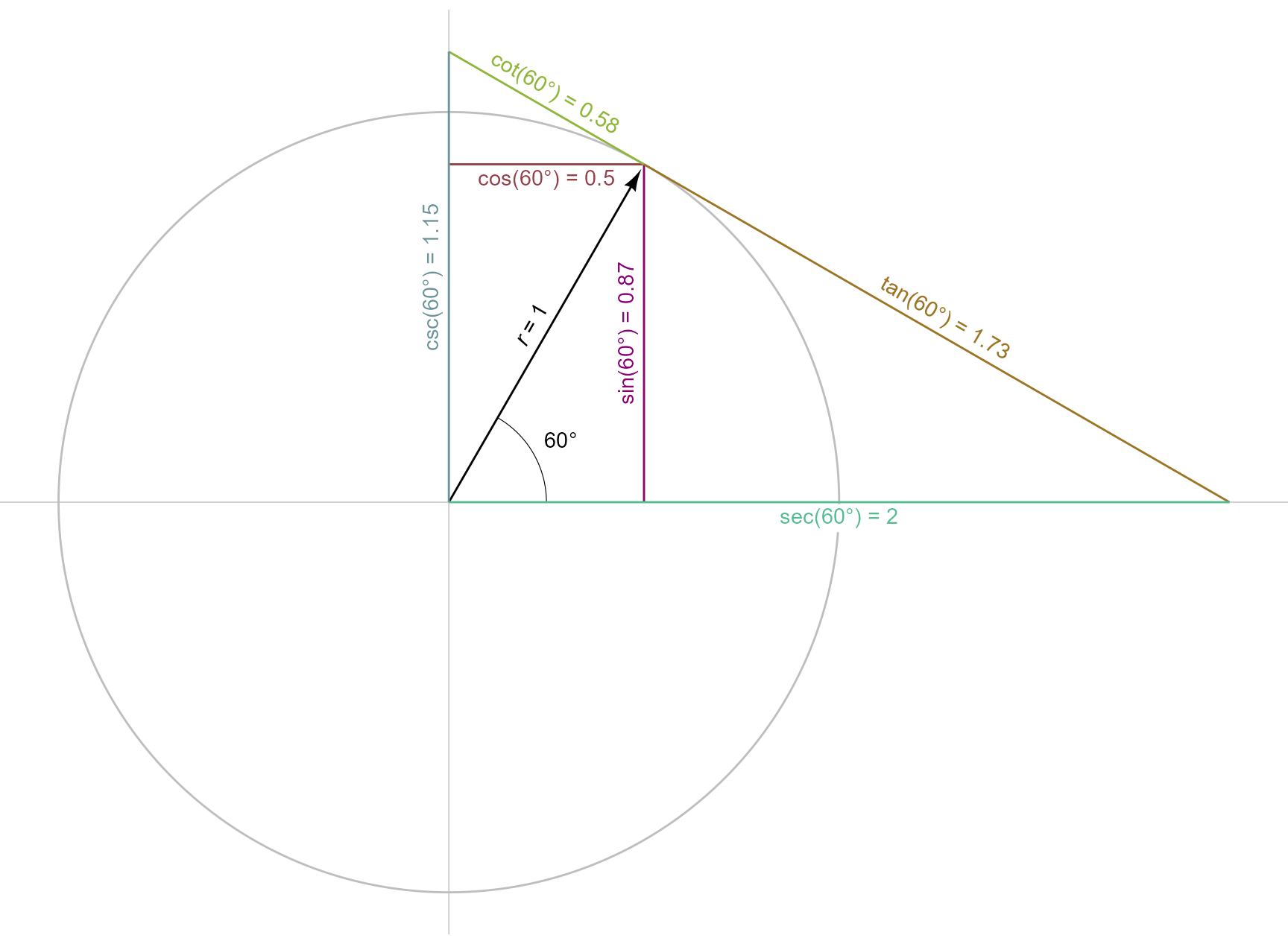
Benefits of using trigonometric functions with angles instead of numeric radians include:
- Angle metric conversions are handled automatically.
- Under the hood, the
cospi,sinpi, andtanpifunctions are used to get the rounding right on key locations (e.g., 90 degrees, 180 degrees)
For example, tan(pi) is slightly off from its true value of 0.
tan(pi)
#> [1] -1.224647e-16By contrast, tan(radian(pi)) rounds to 0 exactly.
Retrieving the underlying data from a ob_angle object
Angles created with the degree, radian, or turn function are ob_angle objects. The ob_angle function exists but is not meant to be used directly. Its underlying data is a vector of numeric data representing the number of turns. The underlying turn data from any ob_angle object can be extracted with the c function (or with the S7::S7_data function).
